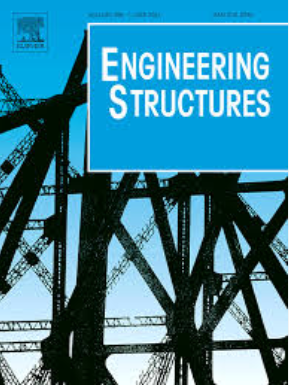基于紧凑带宽正则化和频谱能量度量的高效自动模态分离及其在桥梁结构长时间连续监测中的应用
IF 6.4
1区 工程技术
Q1 ENGINEERING, CIVIL
引用次数: 0
摘要
模态参数是反映工程结构动力特性的基本指标。从测量数据中自动提取结构模态对结构健康监测至关重要。本文提出了一种新的自动模态分离方法,便于在波动环境条件下进行实时模态识别。本方法利用一种被称为紧凑带宽正则化方法的盲源分离技术,从测量的加速度中依次提取固有频率和模态振型。为了解决连续监测过程中活动模式数量的不确定性,建立了基于频谱能量和功率谱熵的准则,实现了模式的自动分离,赋予了算法自适应能力。此外,采用相似准则区分噪声模态和结构模态,保证了识别的有效性。通过一个六层剪力建筑模型的数值模拟,验证了该方法的准确性和自动化程度。并将该方法应用于某大跨度悬索桥的长期振动监测。一年的辨识结果表明,该方法能够自主高效地提取主动模式,满足实时性应用要求。此外,通过涡激振动的实例研究,强调了该方法在检测共振初期阶段的推导能力。本文章由计算机程序翻译,如有差异,请以英文原文为准。

Efficient and automatic mode separation based on compact-bandwidth regularization and spectral-energy metrics with application to long-time continuous monitoring of bridge structures
Modal parameters are fundamental indicators of the dynamic characteristics of engineering structures. Automatic extraction of the structural modes from measured data is essential for structural health monitoring. This study presents a novel automatic mode separation method, facilitating real-time modal identification in fluctuating environmental conditions. The present method sequentially extracts natural frequencies and mode shapes from measured accelerations via utilizing a blind source separation technique known as the Compact-Bandwidth Regularization approach. To address the uncertainty in the number of active modes during continuous monitoring, criteria grounded in spectral energy and power spectral entropy are formulated, enabling the automatic mode separation and endowing the algorithm’s adaptive capabilities. Additionally, a similarity criterion is employed to differentiate between noise modes and structural modes, ensuring the validity of the identification. The accuracy and automation of the method are confirmed through numerical simulations involving a six-storey shear building model. Emphasizing practical application, the proposed method is applied to a long-span suspension bridge equipped with long-term vibration monitoring system. The one-year identification outcomes demonstrate that the proposed method can autonomously and efficiently extract active modes, fulfilling the requirements for real-time applications. Furthermore, the method’s derivational ability to detect the incipient stages of resonance is highlighted through a case study of vortex-induced vibration.
求助全文
通过发布文献求助,成功后即可免费获取论文全文。
去求助
来源期刊

Engineering Structures
工程技术-工程:土木
CiteScore
10.20
自引率
14.50%
发文量
1385
审稿时长
67 days
期刊介绍:
Engineering Structures provides a forum for a broad blend of scientific and technical papers to reflect the evolving needs of the structural engineering and structural mechanics communities. Particularly welcome are contributions dealing with applications of structural engineering and mechanics principles in all areas of technology. The journal aspires to a broad and integrated coverage of the effects of dynamic loadings and of the modelling techniques whereby the structural response to these loadings may be computed.
The scope of Engineering Structures encompasses, but is not restricted to, the following areas: infrastructure engineering; earthquake engineering; structure-fluid-soil interaction; wind engineering; fire engineering; blast engineering; structural reliability/stability; life assessment/integrity; structural health monitoring; multi-hazard engineering; structural dynamics; optimization; expert systems; experimental modelling; performance-based design; multiscale analysis; value engineering.
Topics of interest include: tall buildings; innovative structures; environmentally responsive structures; bridges; stadiums; commercial and public buildings; transmission towers; television and telecommunication masts; foldable structures; cooling towers; plates and shells; suspension structures; protective structures; smart structures; nuclear reactors; dams; pressure vessels; pipelines; tunnels.
Engineering Structures also publishes review articles, short communications and discussions, book reviews, and a diary on international events related to any aspect of structural engineering.
 求助内容:
求助内容: 应助结果提醒方式:
应助结果提醒方式:


